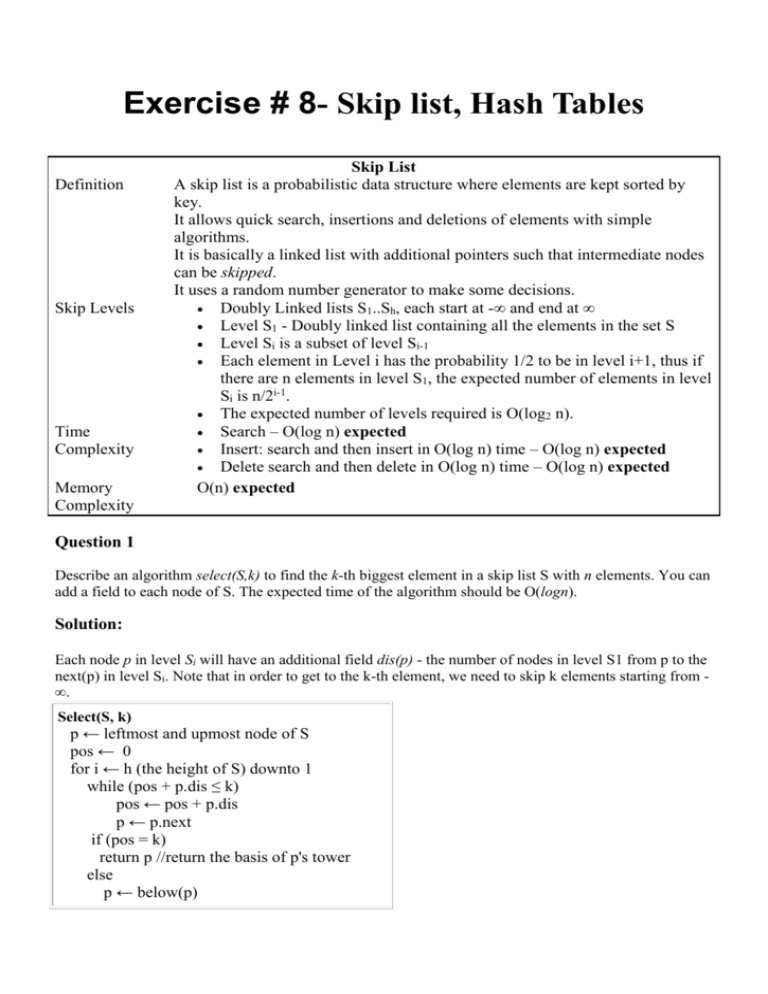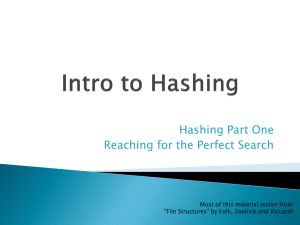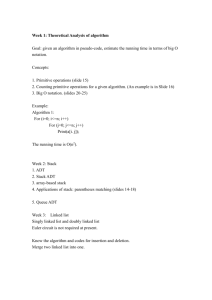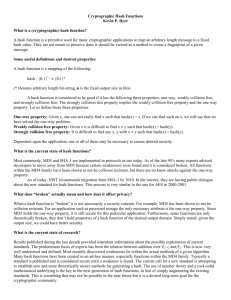DOCX
advertisement

Exercise # 8- Skip list, Hash Tables
Definition
Skip Levels
Time
Complexity
Memory
Complexity
Skip List
A skip list is a probabilistic data structure where elements are kept sorted by
key.
It allows quick search, insertions and deletions of elements with simple
algorithms.
It is basically a linked list with additional pointers such that intermediate nodes
can be skipped.
It uses a random number generator to make some decisions.
Doubly Linked lists S1..Sh, each start at -∞ and end at ∞
Level S1 - Doubly linked list containing all the elements in the set S
Level Si is a subset of level Si-1
Each element in Level i has the probability 1/2 to be in level i+1, thus if
there are n elements in level S1, the expected number of elements in level
Si is n/2i-1.
The expected number of levels required is O(log2 n).
Search – O(log n) expected
Insert: search and then insert in O(log n) time – O(log n) expected
Delete search and then delete in O(log n) time – O(log n) expected
O(n) expected
Question 1
Describe an algorithm select(S,k) to find the k-th biggest element in a skip list S with n elements. You can
add a field to each node of S. The expected time of the algorithm should be O(logn).
Solution:
Each node p in level Si will have an additional field dis(p) - the number of nodes in level S1 from p to the
next(p) in level Si. Note that in order to get to the k-th element, we need to skip k elements starting from ∞.
Select(S, k)
p ← leftmost and upmost node of S
pos ← 0
for i ← h (the height of S) downto 1
while (pos + p.dis ≤ k)
pos ← pos + p.dis
p ← p.next
if (pos = k)
return p //return the basis of p's tower
else
p ← below(p)
Complexity: O(log n) .
Example: When searching for the 7-th key (31) the search path is : -∞, next to 2, next to 15, down to 15,
next to 23, down to 31.
Note: keeping such field does NOT affect the time complexity of Insert, Delete.
Question 2
Write an algorithm that builds a skip list S from the given BST T with n elements, such that the worst
query time in S will be O(log n). T can be unbalanced. The time complexity of the algorithm should be
O(n).
Solution:
Build(T, S)
S1inorder(T)
int i1
while (i < log n)
for j1 to |Si|
if (j mod 2 = 0)
link = Si+1.add(Si[j]) //method
returns a pointer to the link added.
link.below = Si[j]
ii+1
Time Complexity: The inorder traversal is O(n). The running time of the rest of the algorithm is linear in
the number of elements in the skip list, that is O(n). The worst query time in such a skip list is O(log n).
This question demonstrates how to construct a deterministic skip-list from an ordered set of n keys in
O(n) time.
Hash Tables
Hash Function
A hash function h maps keys of a given type into integers in a fixed
interval [0,m-1]
Uniform Hash
Prh(key) i
Hash Table
A hash table for a given key type consists of:
Hash function h: keys-set →[0,m-1]
Array (called table) of size m
Direct Addressing
K is a set whose elements' keys are in the range [0,m-1].
Use a table of size m and store each element x in index x.key.
Disadvantage: when |K| << m → waste of space
Chaining
h(k) = k mod m (This is an example of a common hash function)
If h(k) is occupied, add the new element in the head of the chain at index h(k)
Open Addressing
1
, where m is the size of the hash table.
m
Basic idea: if slot is full, try another slot until an open slot is found
(Probing).
Search is similar to insert and is a good solution for fixed sets.
Deletion – need to mark slot during deletion, search time is no longer
dependent on 𝛼.
Linear Probing:
h(k,i) = (h'(k) + i)mod m 0≤ i ≤ m-1
h'(k) - common hash function
First try h(k,0) = h'(k) , if it is occupied, try h(k,1) etc. ...
Advantage: simplicity
Disadvantage: clusters, uses Θ(m) permutations of index addressing sequences
Double Hashing:
h(k,i) = (h1(k) + i·h2(k))mod m 0≤ i ≤ m-1
h1 – hash function
h2 – step function – also a hash function
First try h(k,0) = h1(k), if it is occupied, try h(k,1) etc. ...
Advantage: less clusters , uses Θ(m*m) permutations of index addressing
sequences
Load Factor α
Average (expected)
Open Addressing
n
, Hash table with m slots that stores n elements (keys)
m
Search Time
unsuccessful search: O(1+1/(1-α))
successful search: O(1+ (1/α)ln( 1/(1-α)))
Chaining
unsuccessful search: Θ (1 + α)
successful search: Θ (1 + α/2) = Θ (1 + α)
Dictionary ADT
The dictionary ADT models a searchable collection of key-element items, and
supports the following operations:
Insert
Delete
Search
Bloom Filter
A Bloom filter model consists of a bit-Array of size m (the bloom filter) and k hash
functions h1, h2, ... hk. It supports insertion and search queries only:
Insert at O(1)
Search(x) in O(1), with (1-e kn / m ) k probability of getting a false positive
Remarks:
1. The efficiency of hashing is examined in the average case, not the worst case.
2. Load factor defined above is the average number of elements that are hashed to the
same value.
3. The fact that the runtime is expected runtime stems from the "randomization" of the
hush function (or the very nature of it) and not from an assumption on the uniformity of
the keys.
4. Let us consider chaining:
The load factor is the average number of elements that are stored in a single linked list.
If we examine the worst-case, then all n keys are hashed to the same cell and form a
linked list of length n. Thus, running time of searching of an element in the worst case
is (Θ(n)+ the time of computing the hash function). So, it is clear that we are not using
hash tables due to their worst case performance, and when analyzing running time of
hashing operations we refer to the average case.
Question 3
Given a hash table with m=11 entries and the following hash function h1 and step function h2:
h1(key) = key mod m
h2(key) = {key mod (m-1)} + 1
Insert the keys {22, 1, 13, 11, 24, 33, 18, 42, 31} in the given order (from left to right) to
the hash table using each of the following hash methods:
a. Chaining with h1 h(k) = h1(k)
b. Linear-Probing with h1 h(k,i) = (h1(k)+i) mod m
c. Double-Hashing with h1 as the hash function and h2 as the step function
h(k,i) = (h1(k) + ih2(k)) mod m
Solution:
Chaining
Linear Probing Double Hashing
0
33 → 11→ 22 22
22
1
1
1
1
2
24 → 13
13
13
3
11
4
24
11
5
33
18
6
7
31
18
18
8
9
10
24
33
31→ 42
42
31
42
Question 4
a. For the previous h1 and h2, is it OK to use h2 as a hash function and h1 as a step function?
b. Why is it important that the result of the step function and the table size will not have a common
divisor? That is, if hstep is the step function, why is it important to enforce GCD(hstep(k),m) = 1 for every
k?
Solution:
a. No, since h1 can return 0 and h2 skips the entry 0. For example, key 11 h1(11) = 0 , and all the steps
are of length 0, h(11,i) = h2(11) + i*h1(11) = h2(11) = 2. The sequence of index addressing for key 11
consists of only one index, 2.
b. Suppose GCD(hstep(k),m) = d >1 for some k. The search after k would only address 1/d of the hash
table, as the steps will always get us to the same cells. If those cells are occupied we may not find an
available slot even if the hast table if not full.
48
Example: m = 48, hstep(k) = 24 ,GCD(48,24) = 24 only
2 cells of the table would be addressed.
24
There are two guidelines on choosing m and step function so that GCD(hstep(k),m)=1:
1. The size of the table m is a prime number, and hstep(k) < m for every k. (An example for this is
illustrated in Question1 ).
2. The size of the table m is 2x, and the step function returns only odd values.
Question 5
Consider two sets of integers, S = {s1, s2, ..., sm} and T = {t1, t2, ..., tn}, m ≤ n.
a. Describe a deterministic algorithm that checks whether S is a subset of T.
What is the running time of your algorithm?
b. Devise an algorithm that uses a hash table of size m to test whether S is a subset of T.
What is the average running time of your algorithm?
c. Suppose we have a bloom filter of size 𝑟, and 𝑘 hash functions h1, h2, …hk : U → [0, r-1] (U is
the set of all possible keys).
Describe an algorithm that checks whether S is a subset of T at O(n) worst time. What is the
probability of getting a positive result although S is not a subset of T?
(As a function of n, m, r and |S∩T|, you can assume k = O(1))
Solution:
a)
Subset(T,S,n,m)
T=sort(T)
for each sj S
found = BinarySearch(T, sj)
if (!found)
return "S is not a subset of T"
return "S is a subset of T"
Time Complexity: O(nlogn+mlogn)=O(nlogn)
b) The solution that uses a hash table of size 𝑚 with chaining:
SubsetWithHashTable(T,S,n,m)
for each ti T
insert(HT, ti)
for each sj S
found = search(HT, sj)
if (!found)
return "S is not a subset of T"
return "S is a subset of T"
Time Complexity Analysis:
Inserting all elements ti to HT: n times 𝑂(1) = 𝑂(𝑛)
𝛼
If S ⊆ T then there are m successful searches: 𝑚 (1 + 2 ) = 𝑂(𝑚)
If S ⊈ T then in the worst case all the elements except the last one, sm is in S, are in T, so
𝛼
there are (m-1) successful searches and one unsuccessful search: (𝑚 − 1) (1 + 2 ) +
(1 + 𝛼) = 𝑂(𝑚)
Time Complexity: 𝑂(𝑛 + 𝑚) = 𝑂(𝑛)
c) We first insert all the elements in T to the Bloom filter. Then for each element x in S we query
search(x), once we get one negetive result we return FALSE and break, if we get positive results
on all the m queries we return TRUE.
Time Complexity Analysis:
n Insertions and m search queries to the bloom filter:
n•O(k) + m•O(k) = (n+m)•O(1) = O(n)
The probability of getting a false positive result:
Denote t = |S∩T|, for all t elements in |S∩T| we will get a positive result, the probability
that we get a positive result for each of the m-t elements in |S\T| is ~ (1-e kn / r ) k and thus
the probability of getting a positive result for all these m-t elements and so returning a
TRUE answer although S ⊈ T is ~ (1-e kn / r ) k ( m t )
Note that the above analysis (b and c) gives an estimation of average run time
Question 6
You are given an array A[1..n] with n distinct real numbers and some value X. You need to
determine whether there are two numbers in A[1..n] whose sum equals X.
a. Do it in deterministic O(nlogn) time.
b. Do it in expected O(n) time.
Solution a:
Sort A (O(nlogn) time). Pick A[1]. Perform a binary search (O(logn) time) on A to find an
element that is equal to X-A[1]. If found, you’re done. Otherwise, repeat the same with A[2],
A[3], …
Overall O(nlogn) time
Solution b:
1. Choose a universal hash function h from a universal collection of hash functions H.
2. Store all elements of array A in a Hash table of size n using h and chaining.
3. For (i = 1; i <= n; i++) {
If ((A[i] is in Table) && (X-A[i] is in Table)) {
Return true
}
Return false
Time Complexity: We don't know if the elements inside the array distribute randomly. If they do not
distribute randomly then using a "regular" hash function can result in α = O(n) and then the runtime could
be O(n^2).
If we use a universal hash function then regardless of the keys distribution the probability that two keys
collide is no more than 1/m = 1/n. As seen in class if we use chaining and a universal hash function then
the expected search time is O(1) and the expected runtime for the algorithm is O(n).
Question 7
Suppose we have n elements and a very good hash function. We have a hash table with
m=n(1.5) double slots, that is, each hash table slot can hold two elements. We perform insert and
search in the obvious manner, checking both slots if necessary, but we do not implement any
collision resolution as in open addressing. Instead, we have an overflow linked list for those
elements that do not fit. This list accepts all overflow elements, regardless of where they come
from. Clearly, one must search the overflow list after having inspected a full slot. Show that the
expected unsuccessful search time is O(1). In other words, show that the expected number of
elements in the overflow list is O(1)(Hint: look at the total number of triples of n elements, and
what is the chance that the hash function takes a triple to the same slot) .
Solution:
Number of triplets among n indices = Θ(n3)
The probability for two keys to fall into the same slot 1/m
The probability of a triplet to fall into the same slot 1/m2
m = n(1.5) so the average number of collisions which will cause a key to go into the overflow list is:
Θ(n3)/m2 = Θ(n3)/n3 = O(1)
Question 8
In a hash table with double hashing (without deletions) assume that in every entry i in the table we keep a
counter ci where ci is the number of keys k in the table such that h1(k) = i.
a. How would you use this fact in order to reduce (on average) the number of accesses to the table
entries during an unsuccessful search?
b. Show an example of an unsuccessful search in which the number of accesses to table entries is
reduced from n to 2 (using your answer to item a).
c. Does this algorithm work for the linear probing method as well?
Solution:
a.
Search(HT,m,k,h)
index=h(k,0)
c=cindex
i=0
do
if c = 0
return -1
if HT[h(k,i)] is empty
return -1
if HT[h(k,i)] = k
return h(k,i)
else
k'=HT[h(k,i)]
if (h(k',0) = index)
c = c-1
i = i+1
while (i < m)
𝟏
The expected number of probes in an unsuccessful search is at most 𝑶(𝟏 + 𝟏−𝒄
𝑴𝒂𝒙
), where 𝒄𝒎𝒂𝒙 is the
maximal counter in the table.
b. m= 7
h1(k) = k mod 7
h2(k) = (k mod 6)+1
Inserting the keys in the following order { -3, 3, 1, 8, 9, 12,21} results in the next hash table:
0 8
c0=1
1 1
c1=2
2 9
c2=1
3 3
c3=1
4 -3 c4=1
5 12 c5=1
6 21 c6=0
Searching for key 29 takes 2 accesses to table entries instead of 7.
c. The algorithm will work for linear probing as well. Again, we might end up accessing almost over all
table entries. The algorithm improves search time significantly if the table is sparse.
Question 9
In Moshe's grocery store, an automatic ordering system that uses a Queue (FIFO) is installed.
Whenever a client places an order, the order's data (product, quantity, client's name) are being
inserted to the back of the Queue. Moshe is extracting orders from the front of the queue, handling
them one by one. In order to avoid a scenario where the store runs out of some product, every time
Moshe extracts an order from the front of the Queue, he would like to know the total quantity of
the currently extracted product, summed over all of this product's orders in the Queue.
Find a data structure that supports the following operations in the given time:
1. Enqueue(r)-Inserting an order to the back of the queue, r = (product, quantity, client's
name). Running time - O(1) on average.
2. Dequeue()-Extracting an order from the front of the queue. Running time - O(1) on
average.
3. Query(p)-Returns the total quantity of the product p in the Queue - O(1) on average.
It is known that there are n products in the grocery. The Queue may hold at most m orders at any
given time. We know that m<n. The data structure may use O(m) memory.
Solution:
We will use a Queue and a hash table with chaining of size O(m). Each element (in the linked list)
contains a key – the product's name and another field – its quantity.
1. Enqueue(r) – Insert the order to the back of the queue. Search for r.product in the hash
table. If r.product is in the table, add r.quantity to the quantity field of the appropriate
element. If not, insert r.product to the hash table and update its quantity.
2. Dequeue() – Extract r from the front of the queue. Search for r.product in the hash table (it
must be in it). Decrement the quantity field of the element by r.quantity. If the quantity is
0, remove the element from the hash table.
3. Query(p) – Look for p in the hash table. If p is in the table, return p.quantity else return 0.
numberOfDifferent Pr oductsInQueue
m
O(1) ; therefore, the
SizeOfHashTable
(m)
running time of the three operations is O(1) in average.
Notice that








